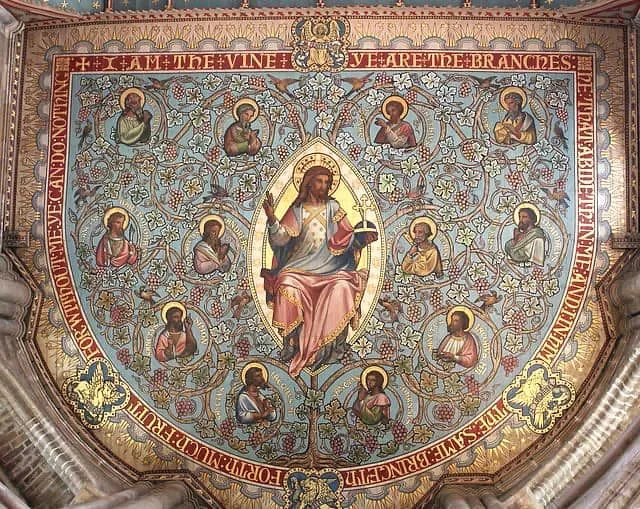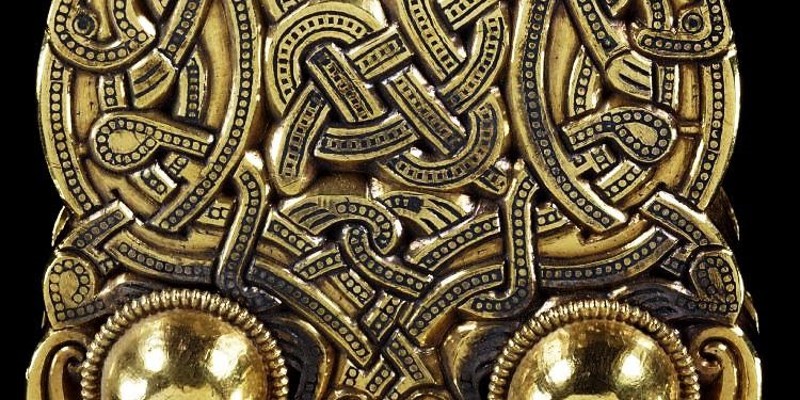Anglo-Saxon art covers art produced during the Anglo-Saxon period of English history, beginning with the style of the Migration Period, which the Anglo-Saxons brought with them from the continent in the 5th century, and ending with the Norman Conquest in 1066.
Two periods of outstanding achievement were in the 7th and 8th centuries, when metalwork and jewelery from Sutton Goo and a number of fine manuscripts were produced, and the period after c.950, when there was a revival of English culture after the end of the Viking invasions.
By the time of the Norman Conquest, the transition to the Romanesque style was practically complete. Important artistic centers (as far as it is fashionable to define) were concentrated in different parts of England – in Northumbria, especially in the early period, and Wessex and Kent near the south coast.

Anglo-Saxon art survives mainly in illustrated manuscripts, Anglo-Saxon architecture, a number of very sophisticated ivory carvings, and some metalwork and other materials. The Opus Anglicanum (“English Work”) was recognized as the best embroidery of the period in Europe, although only a few pieces from the Anglo-Saxon period survive (the Bayeux Tapestry is rather a different type of embroidery, on a much larger scale). As in most countries of Europe at that time, the Anglo-Saxons most highly valued metalwork, but almost nothing survived from it – there was a colossal looting of Anglo-Saxon churches, monasteries and the property of dispossessed nobles by the new Norman rulers in the first decades after the conquest, as well as by the Scandinavians before them, and the English Reformation destroyed the remnant; most of the survivors are on the continent. Anglo-Saxon taste favored brightness and color, and one often has to use the imagination to see excavated or worn objects in their original form.
Perhaps the most famous piece of Anglo-Saxon art is the Bayeux Tapestry, which was commissioned by a Norman patron from English artists working in the traditional Anglo-Saxon style. Anglo-Saxon artists also worked on frescoes, stone, ivory and whalebone (e.g. Frankish box), metal (e.g. Fuller’s brooch), glass and enamel. Many examples have been found through archaeological excavations, and some have simply survived for centuries, especially in temples on the Continent, as the Vikings, Normans and Reformation iconoclasm left little to nothing in England except books and archaeological finds.
Review
Metalwork is almost the only form in which the earliest forms of Anglo-Saxon art survive, mainly in Germanic-style jewelry (fastening and decoration of clothing and weapons), which, before the Christianization of Anglo-Saxon England, was often placed in burials . After the conversion to Christianity, which took up most of the 7th century, the fusion of Germanic Anglo-Saxon, Celtic, and late antique techniques and motifs, together with the need for books, produced the Hiberno-Saxon style, or insular art, which also appears in illuminated manuscripts and some works of carved stone and bone, which most likely borrow from decorative works on metal, and with the further influence of the British Celts of the west and the Franks. The kingdom of Northumbria in northern England was the crucible of the Insular style in Great Britain in centers such as Lindisfarne Abbey, founded c. 635 as an offshoot of the Irish monastery on the island of Iona, and Monkvermouth-Jarrow Abbey (674), which practiced continental Christianity. At about the same time as the insular Lindisfarne Gospels in the early 8th century, the Vespasian Psalter of Canterbury in the south, where the missionaries from Rome had their headquarters, shows a completely different style based on classical art. These two styles mixed and developed together and in the following century resulted in the mature Anglo-Saxon style.

However, Anglo-Saxon society was massively disrupted in the 9th century, especially in the second half, by the Viking invasions, and the number of significant objects that have survived drops significantly, and their dating becomes even more obscure than those created a century earlier. Most monasteries in the north were closed for many decades, if not forever, and after the Canterbury Bible (before 850, possibly earlier), “no serious illuminated manuscripts are known until the tenth century”. King Alfred (871-899) kept the Vikings on a line running diagonally across the middle of England, over which they settled at Denlo, and were gradually integrated into what was a single Anglo-Saxon kingdom.
The final phase of Anglo-Saxon art is known as the Winchester School, although objects in this style were produced at many centers in the south of England, and possibly also in the Midlands. Elements of this style begin to appear around 900, but the first large manuscripts appear around the 930s. The style combined influences from continental Holy Roman art with elements of older English art, and had some distinct elements, including a nervous, agitated style of drapery to which the figures correspond, especially in line drawings, which are the only type of imagery in many manuscripts; it remained particularly prominent in medieval English art.
